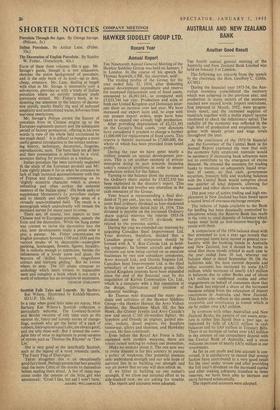Porcelain Through the Ages. By George Savage. (Pelican. 5s.) The
Decoration of English Porcelain. By Stanley W. Fisher. (Verschoyle. 42s.) EACH of these three volumes fills a gap. Mr. Savage's guide, though it is not exhaustive, sketches the entire background of porcelain, and is the only book of its kind—up to date, cheap, extensive. Mr. Lane, dealing at length with what in Mr. Savage is necessarily only a sub-section, provides us with a 'study of Italian porcelain where no entirely adequate study previously existed. Mr. Fisher's book, in re- directing our attention to the history of decora- tive motifs, marks finally thg end of enforced simplicity and undecorated wares, left-overs from war-time restrictions.
Mr. Savage's Pelican covers the history of porcelain from its Chinese origins up to the European eighteenth century and the subsequent period of factory production, offering in his own words `a view of the whole field uncluttered by too much detail.' It is difficult to imagine a more useful general introduction to the subject embrac- ing history, techniques, decoration, forgeries, reproductions, taste. The basic facts are all here and their presentation is informed by a vivid, sensuous feeling for porcelain as a medium.
Italian porcelain has been curiously neglected
ifi the study of the European product and Mr. Lane rightly places it for us when he contrasts its lack of high technical accomplishment with that of France and Germany, commenting on its 'slightly eccentric character which is always refreshing and often evokes the welcome memory of the Italian scene.' His book seeks to supplement Morazzoni's Le porcellane italiane and to identify and classify large areas of a virtually unco-ordinated field. The result is a monograph which undoubtedly will remain the standard survey for many years to come.
There are, of course, two aspects to later Chinese and to European porcelain, namely the form and the decoration. While the Sung potter was content to incise the decoration into the clay, later developments imply a potter who is also a painter. Mr. Fisher concentrates on English porcelain between 1750 and 1850 and the various modes of its decoration—underglaze painting, landscapes, flowers, figures, heraldry. He is catholic enough to appreciate, besides the' refinements of a lovely paste and glaze, the bravura of 'skilled brushwork, magnificent colours and intricate gilding.' But he knows where to stop. The 137 plates compose an anthology which bears witness to impeccable taste and complete a book which is not only a work of reference but an invitation to enjoyment.
CHARLES TOMLINSON














































 Previous page
Previous page